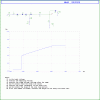Hello again,
The original waveform has these characteristics in the order shown:
1. The output starts out negative (E2).
2. While the input is still negative, the output jumps up suddenly through zero.
3. The output ramps up, passes through the x axis, then stops rising at E1.
4. The output remains at E1 after that.
The above gives us three corners:
1. At some negative Vin and Vout
2. With Vout positive and Vin still negative
3. With both Vin and Vout positive
I dont see three corners in your teachers solution, only two.
The input starts off very negative, and R conducts and D2 conducts and E2
keeps the output clamped at -E2. As the input rises, eventually it reachs
the same voltage as -E2 and that means there is no current flowing in R
and D2 stops conducting. The output is now still at -E2 though because
the input is at -E2. Now the input rises a bit more and so the output
rises too, but it must be ramping already because Vin is ramping over
time. Thus, the output ramps through zero and does not jump up suddenly
as the waveform picture shows it should.
Eventually the input reachs E1, and then diode D1 clamps the output to E1
so it remains at E1.
What the above means is that there is no jump discontinuity as the original
waveform drawing shows.
You'll have to ask the teacher why the waveform shows a jump when the
circuit given does not seem to have that kind of response.
By adding R2 in the drawing below i can get it to look like a jump
occurs, but the jump only happens near the x axis, not before it.
The entire jump is supposed to be over with before the input
reaches zero. Also, then the output ramps up but there is no clamp
at the end.
I included the original waveform drawing and the circuit your teacher
gave too, and the last schematic is the new circuit but that doesnt
work exactly right either.







